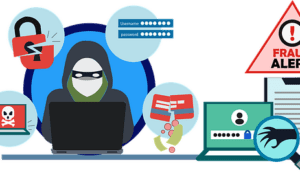Welcome to the wild, wild web! As we navigate through the vast and intricate world of the internet, it’s crucial to equip ourselves with an understanding of its dark side. From cunning hackers to stealthy phishing attacks, the threat landscape has evolved into a sophisticated battlefield. In this blog post, we will delve deep into the realms of cybercrime and unravel the complex tapestry that poses an imminent danger to our virtual existence. Get ready for a riveting journey as we immerse ourselves in exploring how these digital adversaries operate and learn valuable tips on protecting ourselves from their clutches.
What is the threat landscape of the internet?
The threat landscape of the internet is constantly evolving as new threats are created and old threats become more sophisticated. It can be hard to keep up with all the changes, but here is a brief overview of some of the most common threats on the internet today:
Hackers: Hackers are generally considered to be the most common threat on the internet and for good reason. They are incredibly skilled at finding and exploiting vulnerabilities in systems, and their goal is usually to gain access to sensitive information or damage systems/data.
Phishing: Phishing is one of the oldest attacks known to humankind, and it continues to be one of the most common types of cyberattacks. Phishing emails look like they come from legitimate sources like your bank or email provider, but they actually contain malicious content that can install malware on your computer or steal your account information. Spear phishing attacks are particularly dangerous because they use specially designed emails that seem to come from someone you know (like a colleague or friend).
Malware: Malware is software that infected computers with harmful data such as viruses, spyware, and trojans. It’s often used by hackers in order to access personal information or gain entry into networks.
Viruses: Viruses are small pieces of computer code that can damage files or disable systems.
Spyware: Spyware is software that collects personal information (including passwords, credit card numbers, etc.) without your knowledge.
Trojans: Trojans attack computers by entering through security gaps in programs and then performing malicious activities like stealing data or stealing login credentials.
DDoS: DDoS stands for distributed denial of service, and it’s a type of attack where hackers flood a target site with traffic in order to make it inaccessible.
What is a hacker?
Simply put, a hacker is someone who breaks into computer systems outside of their intended purpose. Hackers can access and damage information or equipment as they please, without fear of retribution from the system owner. Attacks can take many different forms, but the basic goal remains the same: to gain unauthorized access to whatever is targets. With the ubiquity of the Internet and its massive base of computers and users, hackers have multiplied exponentially over the years. Today, they are a constant threat to both individuals and businesses alike.
How do hackers attack the internet?
Hackers typically break into systems using one of three methods: via software vulnerabilities such as buffer overflows; through malicious code that infects computers; or by exploiting security flaws in web applications or databases. Once inside, they may explore further for any useful information ( passwords , personal data , etc.) or attempt to harm or steal data or resources valuable to their victim. In order to carry out these attacks undetected, hackers typically employ some form of malware (malicious software) that helps them conceal their presence on infected computers and facilitates their damage operations. As technology advances, so too does hacking methods – meaning that even older systems are at risk from cyber criminals with innovative techniques.
How can businesses protect themselves against hackers?
Businesses can take various measures to defend themselves against hackers, including employing effective cybersecurity protocols and training employees on how to identify potential threats and report them . Additionally, businesses can install effective anti-virus software and employ custom security measures such as firewalls to protect against malicious code and malware. In the case of website attacks, businesses can install intrusion detection and prevention systems that monitor for suspicious activity and take appropriate action before sensitive data is compromised.
What is phishing?
Phishing is a fraudulent act where an individual or company obtains login credentials, financial information, or other confidential information by masquerading as a legitimate entity or site. The practice has become increasingly popular on the internet as hackers have found that phishing is one of the most effective methods of gaining access to individuals’ personal information.
There are a few different types of phishing attacks: spear-phishing is when attack emails are crafted to look like they come from a known source (like your bank), while SMB phishing sees attackers target employees within an organization in order to steal login credentials. Phishers also use Email Manipulation Techniques (EMA) to deceive users into opening attachments or clicking on links that take them to spoof websites. Once users have been compromised, hackers can access their personal information and use it for criminal purposes.
The threat landscape of the internet is constantly changing as criminals continue to find new ways to exploit vulnerabilities and steal users’ data. Phishing remains one of the most common forms of cybercrime and vigilance is essential if you want ensure your personal data isn’t stolen.
How to avoid becoming a victim of online scams
There are a lot of different types of online scams out there, and unfortunately most people don’t even know what they are. This can make it really easy for scammers to take advantage of you. Here are some tips to help you avoid becoming a victim:
1. Be aware that scams exist. There is no way to avoid them completely, but by being aware of them and how they work, you can minimize your chances of getting scammed.
2. Do your research. Before making any decisions online, be sure to do your research. Check the company’s website, news sources, and any other reputable sources to make sure the information you’re considering is actually legitimate.
3. Don’t pay without verification. Always double check the source of the payment before sending anything money to someone you don’t know or trust. Try to get contact details for the person you’re dealing with so that you can verify their story yourself if necessary.
4. Use common sense. When in doubt, err on the side of caution and don’t do anything that seems too risky or unfamiliar. If something feels too good to be true, it probably is!
5. Report suspicious activity Immediately. If something feels wrong or doesn’t seem right 100%, please report it to your internet provider or authorities like the FBI – scam artists rely on people not reporting their experiences for fear of being accused Of being a “snooper”.



































